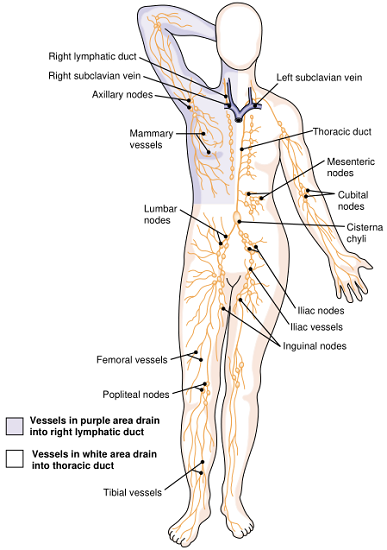The lymphatic system is a widely distributed system with multiple functions (Fig. 1). Its role in circulation is to return excess fluid and proteins from the tissues to the bloodstream. The fluid carried in the lymphatic system is called lymph. Lymph drains from the lower part of the body and the upper left side into the thoracic duct, which travels upward through the chest and empties into the left subclavian vein near the heart. The right lymphatic duct drains the upper right side of the body and empties into the right subclavian vein.
Another function of the lymphatic system is to absorb digested fats from the small intestine. These fats are then added to the blood near the heart.
One other major function of the lymphatic system is to protect the body from impurities and invading microorganisms. Along the path of the lymphatic vessels are small masses of lymphoid tissue, the lymph nodes (see Fig. 1). Their function is to filter the lymph as it passes through. They are concentrated in the cervical (neck), axillary (armpit), mediastinal (chest), and inguinal (groin) regions. The lymph nodes and the remainder of the lymphatic system also play a role in immunity. Other organs and tissues of the lymphatic system include the tonsils, located in the throat, the thymus gland in the chest, and the spleen in the upper left region of the abdomen.

FIGURE 1. Lymphatic system.
责任编辑:admin
上一篇:医学文章阅读——Blood Pressure
下一篇:医学文章阅读——Inflammatory Bowel Disease

微信公众号搜索“译员”关注我们,每天为您推送翻译理论和技巧,外语学习及翻译招聘信息。